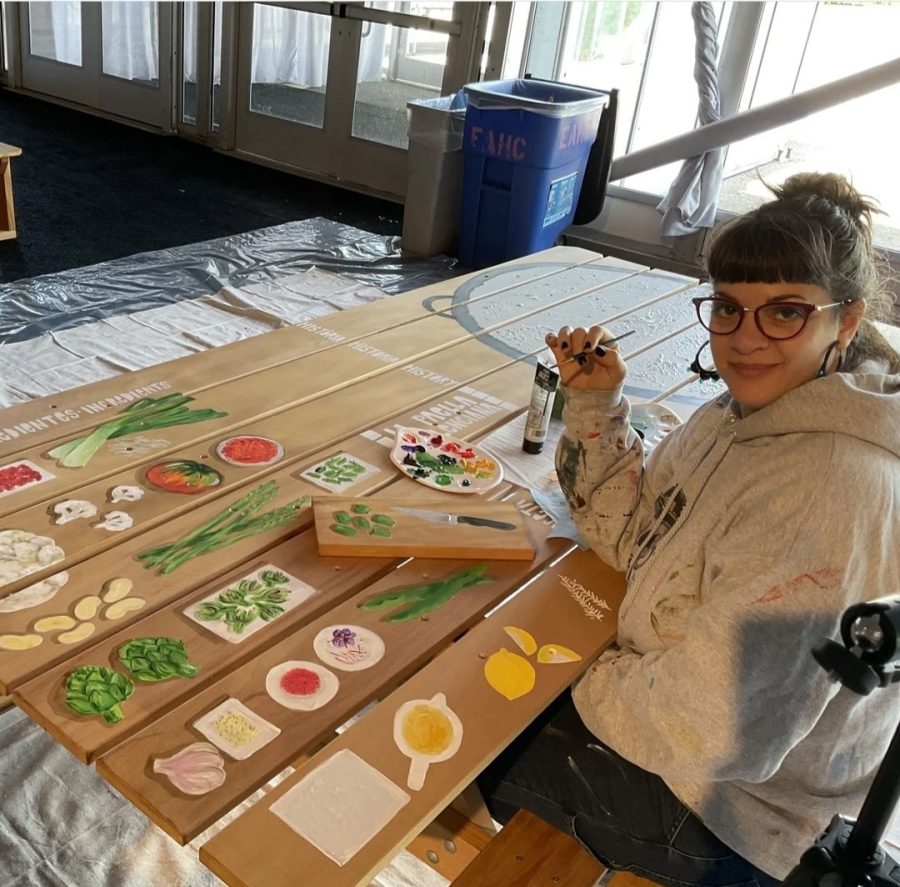Around the Table: Reviewing the NYBG’s Recent Exhibit
The New York Botanical Gardens (NYBG) most recent exhibit, “Around the Table: Stories of the Foods We Love,” wrapped up this Sunday, concluding a four-month long presentation on the origins, history and culture of food for a population largely inexperienced with agriculture and experience of growing one’s own food.
Not concentrated in a single station, but rather spread out across the garden grounds, “Around the Table” demands several hours, perhaps even a full day to explore and fully take in. Among several of the exhibition’s highlights were the African-American Garden, Art & Science displays in the Mertz Library, Bronx Artists Tables and selected plants in the Erin A. Haupt Conservatory — which is located closest to the main entrance.
At first, the experience is purely visual. The initial foray into the Erin A. Haupt Conservatory felt at once overwhelming, nearly freezing you where you stand. With glass walls and foliage stretching upwards to mere feet under the ceiling, your eyes are drawn all over, seldom focusing on a single plant. It sets the tone for the rest of your experience: the exhibition demands a careful, paced attentiveness in order to dissect the masses of green and to understand a plant’s individual significance.
Turning from the first room, you’ll walk a tan stone-tiled path to meet the first of the foods on display. Ceiling fans dispose of any inconvenient heat the summer sun might induce and sway the plants, which wave you onward. Soft laidback music, like the kind you’d hear on a YouTube lofi mix, sets a slow pace for your walk, which is necessary to notice and examine the plaques nestled carefully among several different plants. Most plaques come with a QR code for further learning on the Bloomberg Philanthropies app. The arrangement of the plants is worthy of their own praise: varying heights are interposed but do not confuse your ability to distinguish them. Unique elements, such as bushes of chili peppers and a hanging wall of edible leaves, effectively organize the hall while also being attractions themselves.
A sudden observation is the geographic diversity of the plants shown. A pearl millet plant hailing from West Africa and an olive tree from the Mediterranean accompany each other on the same side of the room. Visitors, especially those from different countries, were able to see foods represented from their own cuisine.
The conservatory contains a diversity of its own, mimicking climates as you travel through. In the arid areas, over ten varieties of aloe with pointed leaves stretch from behind a barrier. In a damp and dark section, you’ll learn that monstera deliciosa, a common houseplant, is actually edible. For perhaps the first time in your life, you will see what sorghum and rice look like above ground as you walk by the koi ponds and the front entrance.
Once the shock of learning, for example, that the glass bottled agave syrup at Whole Foods originates from a gargantuan aloe-like plant five times the size of your body wears off, you are better able to experience the finer nuances of the exhibit. The lack of knowledge about our food isn’t merely technical, we miss out on knowing the tangible look and feel of our produce. Food is all at once: personal, familial, historical, cultural, global and cross-generational.
When asked if she thought the exhibit accurately depicted the complicated and at times detrimental effects of agricultural history of these plants, one visitor, Patricia, agreed it did, noting the specific devastation caused by sugarcane and banana farming in her home country of Brazil. She also remarked of the evolutionary and breeding histories: “[Around the Table] does a good job of explaining how different plants come from one another.”
“Around the Table” simultaneously highlights personal and cultural histories of food. In the Mertz Library Building Galleries, you can visit a vegetarian cookbook exhibit. In a single room are cookbooks from the 1900s and beyond, originating from churches, schools and social movements. Upon exiting the room, visitors can contribute their own recipes and reflections that will get hung up on the fourth floor rotunda.
Bronx artists’ tables each showcase a specific and cultural experience of food. The tables are each different from the next — some are made of yarn and others are painted, some have recipes and others have prayers. The experience of a table encompasses religion, community, culture and creativity, while also adding a layer of depth to the physical plants seen across the gardens.
“I love the tables. I felt each one was so unique… it enhances the plants to see them in artworks,” said one tour guide.
Like the exhibit itself, they are scattered throughout the NYBG, impressing specific experiences of food with the viewer as they experience the grounds as a whole. In front of the dome, one simple brown table appears to be overgrown with moss and dried foliage, with the greenery of succulents and ivy poking through. The plants grow out and push rusting birdcages and chipped teacups to an angle, and a crown of plants rests at the very top. The order and structure of tea and ritual is given over to the whims of nature.
Another tour guide recalled crying upon seeing it. “It had just rained, and the teacups were full of water.”

Adithi Vimalanathan is a junior from Jersey City, New Jersey, pursuing majors in English and economics. She served as Assistant News Editor for Volume...








































































































































































































